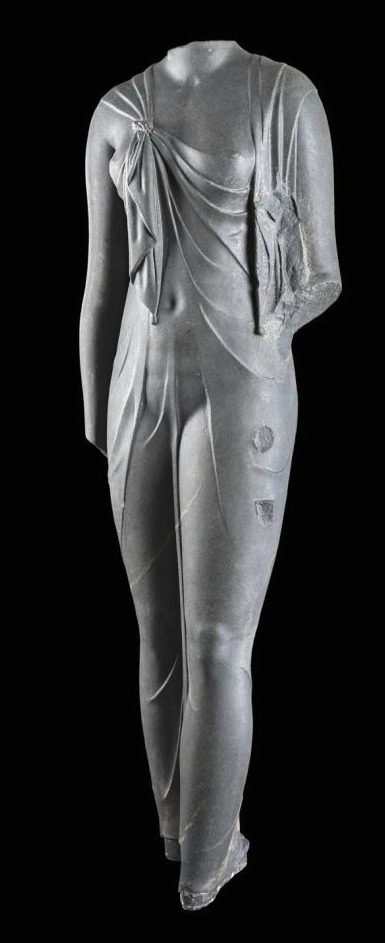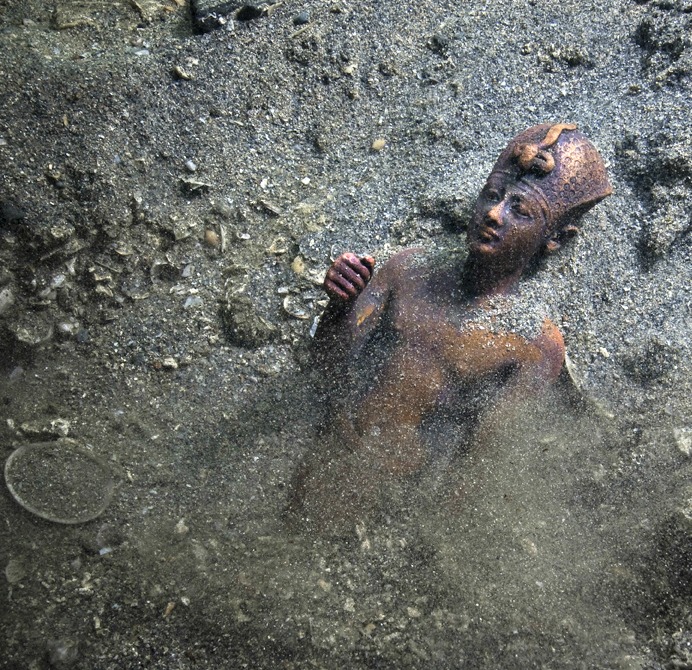Like Gold, Picasso and Impressionism, Egypt has generally been a sure-fire subject for art museums. But, you may think, you know the story–basically. An exhibit at the St. Louis Art Museum will make you think again. Sunken Cities: Egypt’s Lost Worlds, a traveling show that has previously been shown at the British Museum, in Paris and in Zurich, delves into the underwater finds made by Franck Goddio, president of the European Institute for Underwater Archaeology, and his team over the last seven or so years. They discovered the lost cities of Thonis-Heracleion and Canopusin.
 You can see it, from afar, on Monday, Apr. 30, at 10:30 Central Time on Facebook Live: That’s when Lisa Çakmak, SLAM’s associate curator of ancient art, will give a tour for the press, but I think everyone can tune in. Here’s the link to the museum’s Facebook page. And before that, you can watch this short video on YouTube.
You can see it, from afar, on Monday, Apr. 30, at 10:30 Central Time on Facebook Live: That’s when Lisa Çakmak, SLAM’s associate curator of ancient art, will give a tour for the press, but I think everyone can tune in. Here’s the link to the museum’s Facebook page. And before that, you can watch this short video on YouTube.
I was lucky to be in St. Louis in mid-March, as the exhibition was almost completely installed but not yet open to the public, and I am very enthusiastic about this show. It includes about 250 artifacts from the “dig” plus some complementary ones from near the rediscovered underwater city. I met both Goddio and Çakmak, and I learned a lot about Egypt that I had not heard before. Or seen before–for example, the figure at left, a statue of Arsinoe that date to the Ptolemeic period. It’s far from what we conjure when we think about Egyptian sculpture.
Here are the basics from the press release:
Thonis-Heracleion…was built in the Nile delta. The city reached its zenith in the Late Period (664–332 BC), when it served as Egypt’s main Mediterranean port. By 800 AD, different natural catastrophies such as earthquake and soil liquefaction had caused both Thonis-Heracleion and the nearby community of Canopus to submerge, and ruins remained underwater for more than 1,000 years…
The French archeologist’s research has revealed that this area was important both as a center of trade and as a site of religious pilgrimage. The excavation also helped scholars understand the Mysteries of Osiris, an annual water procession along the canals between Thonis-Heracleion and Canopus commemorating one of Egypt’s most important myths—the murder and resurrection of the god Osiris.
Goddio was mesmerizing as he talked about the rebirth myth that he discovered documentation for, the activities of the priests who kept it all secret, the echoes and relationships of many of the works in the exhibit.

If you are near St. Louis, it’s worth a detour.
This was an expensive venture for SLAM–shipping costs alone had to be enormous. In fact, the museum found it less expensive to buy new cases and mounts than to ship the ones that had been used in Europe.
But it was, the museum said, the first substantial exhibit about Egypt in some 50 years. The region could very much benefit from this.
Costs and need may also be the reason the show has a long run–from March 25 through Sept. 9, nearly six months.
A challenge for any museum presenting an extensive, expensive show for that long is sustaining interest. Human nature, we all know, prompts people to go to something like this at the very beginning and the very end. Museums try hard to smooth out the crowds, making the experience a good one for all. Maybe that’s why Facebook Live tomorrow.
So far, I believe, only the Wall Street Journal and Hyperallergic have provided national coverage–here and here. Local coverage was mostly previews. The shrinking of serious arts coverage everywhere is a problem for many institutions, and there’s no sign that this particular situation will improve, sadly.
Photo Credits: Excavations Photo: Christoph Gerigk © Franck Goddio/Hilti Foundation
